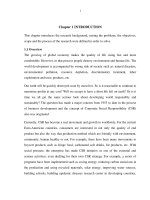social responsibility and managerial ethics
Bạn đang xem bản rút gọn của tài liệu. Xem và tải ngay bản đầy đủ của tài liệu tại đây (410.61 KB, 42 trang )
ninth edition
STEPHEN P. ROBBINS
© 2007 Prentice Hall, Inc.
© 2007 Prentice Hall, Inc.
All rights reserved.
All rights reserved.
PowerPoint Presentation by Charlie Cook
PowerPoint Presentation by Charlie Cook
The University of West Alabama
The University of West Alabama
MARY COULTER
Social Responsibility
Social Responsibility
and Managerial Ethics
and Managerial Ethics
Chapter
Chapter
5
5
© 2007 Prentice Hall, Inc. All rights
reserved. 5–2
L E A R N I N G O U T L I N E
L E A R N I N G O U T L I N E
Follow this Learning Outline as you read and study this chapter
Follow this Learning Outline as you read and study this chapter
.
.
What is Social Responsibility?
What is Social Responsibility?
•
Contrast the classical and socioeconomic views of social
Contrast the classical and socioeconomic views of social
responsibility.
responsibility.
•
Discuss the role that stakeholders play in the four stages
Discuss the role that stakeholders play in the four stages
of social responsibility.
of social responsibility.
•
Differentiate between social obligation, social
Differentiate between social obligation, social
responsiveness, and social responsibility.
responsiveness, and social responsibility.
© 2007 Prentice Hall, Inc. All rights
reserved. 5–3
L E A R N I N G O U T L I N E
L E A R N I N G O U T L I N E
Follow this Learning Outline as you read and study this chapter
Follow this Learning Outline as you read and study this chapter
.
.
Social Responsibility and Economic Performance
Social Responsibility and Economic Performance
•
Explain what research studies have shown about the
Explain what research studies have shown about the
relationship between an organization’s social involvement
relationship between an organization’s social involvement
and its economic performance.
and its economic performance.
•
Define social screening.
Define social screening.
•
Explain what conclusion can be reached regarding social
Explain what conclusion can be reached regarding social
responsibility and economic performance.
responsibility and economic performance.
© 2007 Prentice Hall, Inc. All rights
reserved. 5–4
L E A R N I N G O U T L I N E (cont’d)
L E A R N I N G O U T L I N E (cont’d)
Follow this Learning Outline as you read and study this chapter.
Follow this Learning Outline as you read and study this chapter.
The Greening of Management
The Greening of Management
•
Describe how organizations can go green.
Describe how organizations can go green.
•
Relate the approaches to being green to the concepts of
Relate the approaches to being green to the concepts of
social obligation, social responsiveness, and social
social obligation, social responsiveness, and social
responsibility.
responsibility.
Values-Based Management
Values-Based Management
•
Discuss what purposes shared values serve.
Discuss what purposes shared values serve.
•
Describe the relationship of values-based management to
Describe the relationship of values-based management to
ethics.
ethics.
© 2007 Prentice Hall, Inc. All rights
reserved. 5–5
L E A R N I N G O U T L I N E (cont’d)
L E A R N I N G O U T L I N E (cont’d)
Follow this Learning Outline as you read and study this chapter.
Follow this Learning Outline as you read and study this chapter.
Managerial Ethics
Managerial Ethics
•
Discuss the factors that affect ethical and unethical
Discuss the factors that affect ethical and unethical
behavior.
behavior.
•
Describe the important roles managers play in
Describe the important roles managers play in
encouraging ethical behavior.
encouraging ethical behavior.
© 2007 Prentice Hall, Inc. All rights
reserved. 5–6
L E A R N I N G O U T L I N E (cont’d)
L E A R N I N G O U T L I N E (cont’d)
Follow this Learning Outline as you read and study this chapter.
Follow this Learning Outline as you read and study this chapter.
Social Responsibility and Ethics in Today’s World
Social Responsibility and Ethics in Today’s World
•
Explain why ethical leadership is important.
Explain why ethical leadership is important.
•
Discuss how managers and organizations can protect
Discuss how managers and organizations can protect
employees who raise ethical issues or concerns.
employees who raise ethical issues or concerns.
•
Explain what role social entrepreneurs play.
Explain what role social entrepreneurs play.
•
Describe social impact management.
Describe social impact management.
© 2007 Prentice Hall, Inc. All rights
reserved. 5–7
What Is Social Responsibility?
What Is Social Responsibility?
•
The Classical View
The Classical View
Management’s only social responsibility is to
Management’s only social responsibility is to
maximize profits (create a financial return) by
maximize profits (create a financial return) by
operating the business in the best interests of the
operating the business in the best interests of the
stockholders (owners of the corporation).
stockholders (owners of the corporation).
Expending the firm’s resources on doing “social good”
Expending the firm’s resources on doing “social good”
unjustifiably increases costs that lower profits to the
unjustifiably increases costs that lower profits to the
owners and raises prices to consumers.
owners and raises prices to consumers.
© 2007 Prentice Hall, Inc. All rights
reserved. 5–8
What Is Social Responsibility? (cont’d)
What Is Social Responsibility? (cont’d)
•
The Socioeconomic View
The Socioeconomic View
Management’s social responsibility goes beyond
Management’s social responsibility goes beyond
making profits to include protecting and improving
making profits to include protecting and improving
society’s welfare.
society’s welfare.
Corporations are not independent entities responsible
Corporations are not independent entities responsible
only to stockholders.
only to stockholders.
Firms have a moral responsibility to larger society to
Firms have a moral responsibility to larger society to
become involved in social, legal, and political issues.
become involved in social, legal, and political issues.
“
“
To do the right thing”
To do the right thing”
© 2007 Prentice Hall, Inc. All rights
reserved. 5–9
Exhibit 5–1
Exhibit 5–1
To Whom is Management Responsible?
To Whom is Management Responsible?
© 2007 Prentice Hall, Inc. All rights
reserved. 5–10
Exhibit 5–2
Exhibit 5–2
Arguments For and Against Social Responsibility
Arguments For and Against Social Responsibility
•
For
For
Public expectations
Public expectations
Long-run profits
Long-run profits
Ethical obligation
Ethical obligation
Public image
Public image
Better environment
Better environment
Discouragement of further
Discouragement of further
governmental regulation
governmental regulation
Balance of responsibility
Balance of responsibility
and power
and power
Stockholder interests
Stockholder interests
Possession of resources
Possession of resources
Superiority of prevention
Superiority of prevention
over cure
over cure
•
Against
Against
Violation of profit
Violation of profit
maximization
maximization
Dilution of purpose
Dilution of purpose
Costs
Costs
Too much power
Too much power
Lack of skills
Lack of skills
Lack of accountability
Lack of accountability
© 2007 Prentice Hall, Inc. All rights
reserved. 5–11
From Obligation to Responsiveness to
From Obligation to Responsiveness to
Responsibility
Responsibility
•
Social Obligation
Social Obligation
The obligation of a business to meet its economic and
The obligation of a business to meet its economic and
legal responsibilities and nothing more.
legal responsibilities and nothing more.
•
Social Responsiveness
Social Responsiveness
When a firm engages in social actions in response to
When a firm engages in social actions in response to
some popular social need.
some popular social need.
•
Social Responsibility
Social Responsibility
A business’s intention, beyond its legal and economic
A business’s intention, beyond its legal and economic
obligations, to do the right things and act in ways that
obligations, to do the right things and act in ways that
are good for society.
are good for society.
© 2007 Prentice Hall, Inc. All rights
reserved. 5–12
Exhibit 5–3
Exhibit 5–3
Social Responsibility versus Social Responsiveness
Social Responsibility versus Social Responsiveness
Social Responsibility Social Responsiveness
Major consideration Ethical Pragmatic
Focus Ends Means
Emphasis Obligation Responses
Decision framework Long term Medium and short term
Source: Adapted from S.L. Wartick and P.L. Cochran, “The Evolution of the Corporate
Social Performance Model,” Academy of Management Review, October 1985, p. 766.
© 2007 Prentice Hall, Inc. All rights
reserved. 5–13
Does Social Responsibility Pay?
Does Social Responsibility Pay?
•
Studies appear to show a positive relationship
Studies appear to show a positive relationship
between social involvement and the economic
between social involvement and the economic
performance of firms.
performance of firms.
Difficulties in defining and measuring “social
Difficulties in defining and measuring “social
responsibility” and “economic performance raise
responsibility” and “economic performance raise
issues of validity and causation in the studies.
issues of validity and causation in the studies.
Mutual funds using social screening in investment
Mutual funds using social screening in investment
decisions slightly outperformed other mutual funds.
decisions slightly outperformed other mutual funds.
•
A general conclusion is that a firm’s social
A general conclusion is that a firm’s social
actions do not harm its long-term performance.
actions do not harm its long-term performance.
© 2007 Prentice Hall, Inc. All rights
reserved. 5–14
Exhibit 5–4
Exhibit 5–4
Social Investing
Social Investing
Source: Social Investment Forum Foundation.
© 2007 Prentice Hall, Inc. All rights
reserved. 5–15
The Greening of Management
The Greening of Management
•
The recognition of the close link between an
The recognition of the close link between an
organization’s decision and activities and its
organization’s decision and activities and its
impact on the natural environment.
impact on the natural environment.
Global environmental problems facing managers:
Global environmental problems facing managers:
Air, water, and soil pollution from toxic wastes
Air, water, and soil pollution from toxic wastes
Global warming from greenhouse gas emissions
Global warming from greenhouse gas emissions
Natural resource depletion
Natural resource depletion
© 2007 Prentice Hall, Inc. All rights
reserved. 5–16
How Organizations Go Green
How Organizations Go Green
•
Legal (or Light Green) Approach
Legal (or Light Green) Approach
Firms simply do what is legally required by obeying laws, rules,
Firms simply do what is legally required by obeying laws, rules,
and regulations willingly and without legal challenge.
and regulations willingly and without legal challenge.
•
Market Approach
Market Approach
Firms respond to the preferences of their customers for
Firms respond to the preferences of their customers for
environmentally friendly products.
environmentally friendly products.
•
Stakeholder Approach
Stakeholder Approach
Firms work to meet the environmental demands of multiple
Firms work to meet the environmental demands of multiple
stakeholders
stakeholders
—
—
employees, suppliers, and the community.
employees, suppliers, and the community.
•
Activist Approach
Activist Approach
Firms look for ways to respect and preserve environment and be
Firms look for ways to respect and preserve environment and be
actively socially responsible.
actively socially responsible.
© 2007 Prentice Hall, Inc. All rights
reserved. 5–17
Exhibit 5–5
Exhibit 5–5
Approaches to Being Green
Approaches to Being Green
Source: Based on R.E. Freeman. J. Pierce, and R. Dodd. Shades of Green:
Business Ethics and the Environment (New York: Oxford University Press, 1995).
© 2007 Prentice Hall, Inc. All rights
reserved. 5–18
Evaluating the Greening of Management
Evaluating the Greening of Management
•
Organizations become “greener” by
Organizations become “greener” by
Using the Sustainability Reporting Guidelines to
Using the Sustainability Reporting Guidelines to
document “green” actions.
document “green” actions.
Adopting ISO 14001 standards for environmental
Adopting ISO 14001 standards for environmental
management
management
Being named as one of the 100 Most Sustainable
Being named as one of the 100 Most Sustainable
Corporations in the World.
Corporations in the World.
© 2007 Prentice Hall, Inc. All rights
reserved. 5–19
Values-Based Management
Values-Based Management
•
Values-Based Management
Values-Based Management
An approach to managing in which managers
An approach to managing in which managers
establish and uphold an organization’s shared values.
establish and uphold an organization’s shared values.
•
The Purposes of Shared Values
The Purposes of Shared Values
Guiding managerial decisions
Guiding managerial decisions
Shaping employee behavior
Shaping employee behavior
Influencing the direction of marketing efforts
Influencing the direction of marketing efforts
Building team spirit
Building team spirit
•
The Bottom Line on Shared Corporate Values
The Bottom Line on Shared Corporate Values
An organization’s values are reflected in the decisions
An organization’s values are reflected in the decisions
and actions of its employees.
and actions of its employees.
© 2007 Prentice Hall, Inc. All rights
reserved. 5–20
Exhibit 5–6
Exhibit 5–6
Purposes of Shared Values
Purposes of Shared Values
© 2007 Prentice Hall, Inc. All rights
reserved. 5–21
Exhibit 5–7
Exhibit 5–7
Survey of Stated
Survey of Stated
Values of
Values of
Organizations
Organizations
Percentage of
Core Value
Respondents
Customer satisfaction 77%
Ethics/integrity 76%
Accountability 61%
Respect for others 59%
Open communication 51%
Profitability 49%
Teamwork 47%
Innovation/change 47%
Continuous learning 43%
Positive work environment 42%
Diversity 41%
Community service 38%
Trust 37%
Social responsibility 33%
Security/safety 33%
Empowerment 32%
Employee job satisfaction 31%
Have fun 24%
Source: “AMA Corporate Values Survey,” (www.amanet.org), October 30, 2002.
© 2007 Prentice Hall, Inc. All rights
reserved. 5–22
Managerial Ethics
Managerial Ethics
•
Ethics Defined
Ethics Defined
Principles, values, and beliefs that define what is right
Principles, values, and beliefs that define what is right
and wrong behavior.
and wrong behavior.
© 2007 Prentice Hall, Inc. All rights
reserved. 5–23
Exhibit 5–8
Exhibit 5–8
Factors That Affect Ethical and Unethical Behavior
Factors That Affect Ethical and Unethical Behavior
© 2007 Prentice Hall, Inc. All rights
reserved. 5–24
Factors That Affect Employee Ethics
Factors That Affect Employee Ethics
•
Moral Development
Moral Development
A measure of independence from outside influences
A measure of independence from outside influences
Levels of Individual Moral Development
Levels of Individual Moral Development
–
Preconventional level
Preconventional level
–
Conventional level
Conventional level
–
Principled level
Principled level
Stage of moral development interacts with:
Stage of moral development interacts with:
Individual characteristics
Individual characteristics
The organization’s structural design
The organization’s structural design
The organization’s culture
The organization’s culture
The intensity of the ethical issue
The intensity of the ethical issue
© 2007 Prentice Hall, Inc. All rights
reserved. 5–25
Exhibit 5–9
Exhibit 5–9
Stages of Moral Development
Stages of Moral Development
Source: Based on L. Kohlberg, “Moral Stages and Moralization: The Cognitive-
Development Approach,” in T. Lickona (ed.). Moral Development and Behavior: Theory,
Research, and Social Issues (New York: Holt, Rinehart & Winston, 1976), pp. 34–35.









